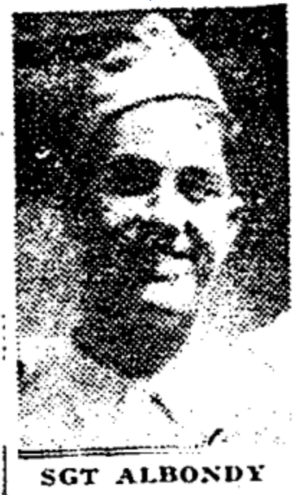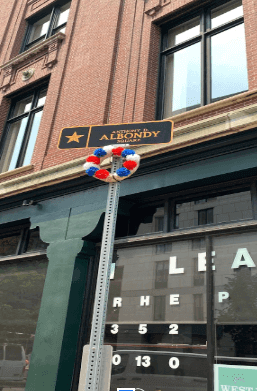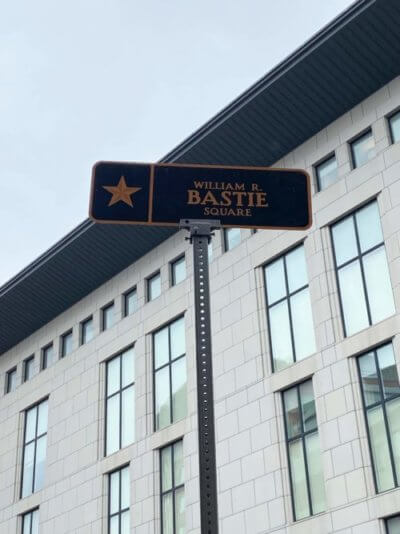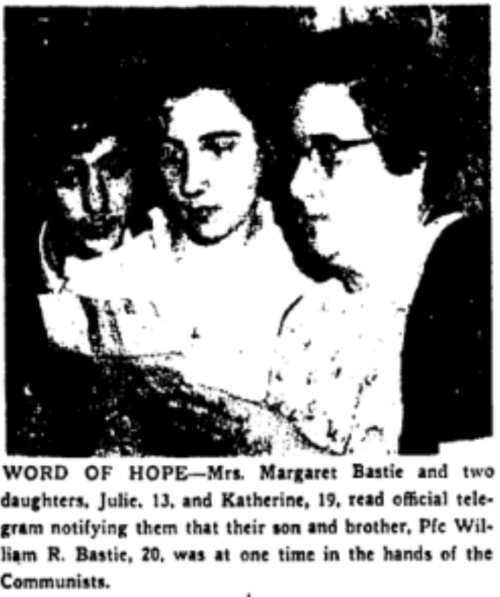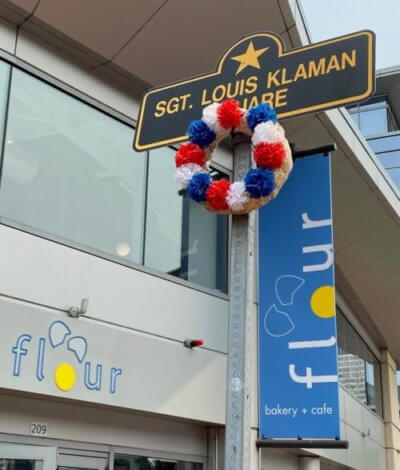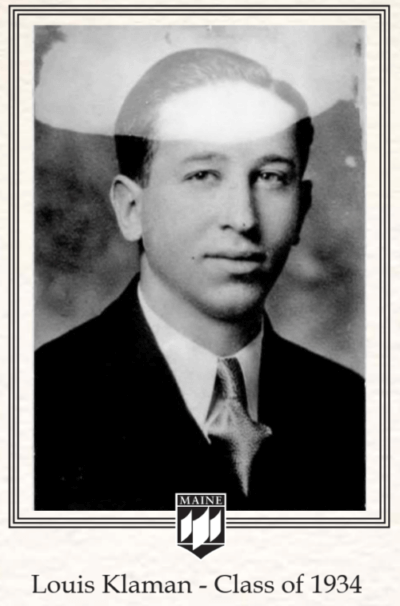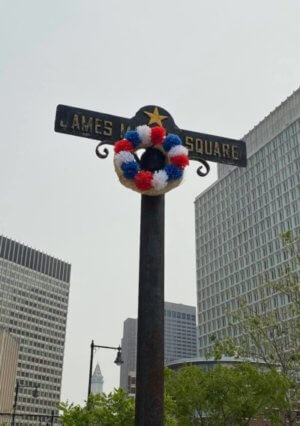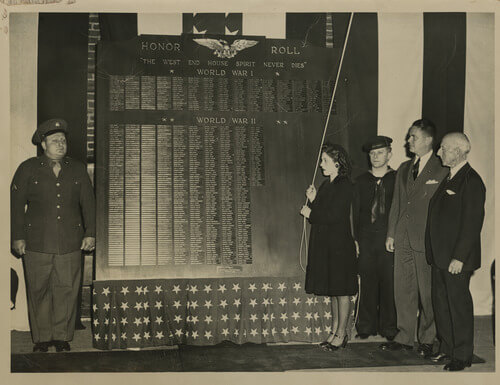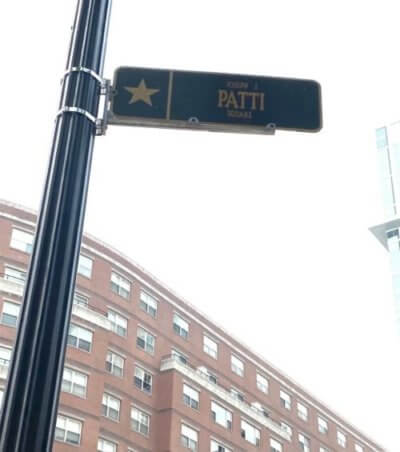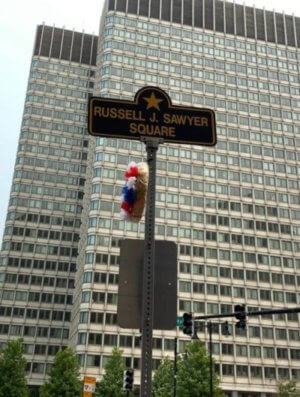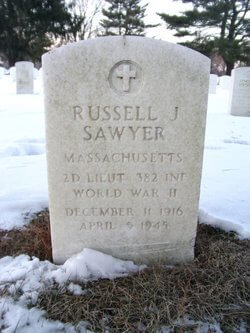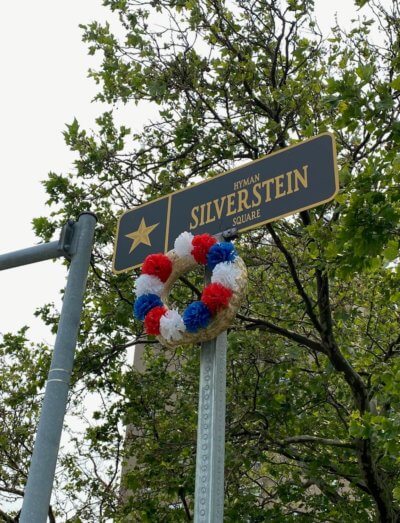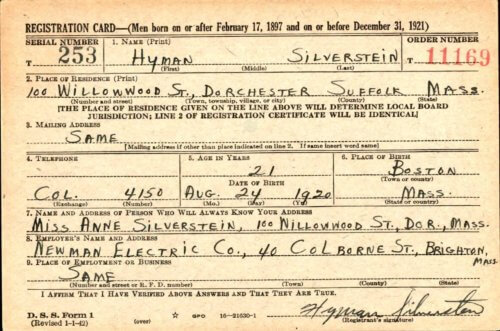West End Hero Squares, Part 2.
Part 1 of West End Hero Squares identified urban squares in the West End which the City of Boston renamed in honor of military personnel who died during service in WW1, and provided background on those soldiers and sailors. Part 2 will look at Hero Squares dedicated to those who served in WWII and the Korean War.
Anthony D. Albondy Square: Junction of Merrimac, Pitts, and Traverse Streets.
Anthony Domenic Albondy was born on December 28, 1919 and lived with his family at 9 South Margin Street in the West End. At the time of his draft registration in 1941, he was twenty one years old and worked as a fish cutter at the Batcheldor & Snyder Co. on Blackstone Street. In 1942 he enlisted in the U.S. Army Air Force and trained as an aerial gunner at Keesler Field, MS, Tyndale Field, FL, and Lowry Field, CO. On February 6, 1945 the Associated Press reported that the B-24 Liberator bomber carrying Sgt. Albondy and his crew mates crashed near the Charleston Army Base in South Carolina. Seven of the crew were killed and five others, including Albondy, were left seriously injured. Unfortunately Sgt. Albondy succumbed to his wounds and died the next day. His funeral was said at St. Joseph’s Church and he was buried at St. Michael’s Cemetery in West Roxbury. A member of the West End House, Sgt. Albondy’s name was entered on the West End House Honor Roll with a star.
William R. Bastie Jr. Square: Junction of Hawkins and New Chardon Streets.
William Roger Bastie Jr. was born on April 22, 1933 and lived at 36 Spring Street in the West End before enlisting in the United States Army on July 21, 1950. Private Bastie served as a Light Weapons Infantryman with Company K, 3rd Battalion, 19th Infantry Regiment, 24th Infantry in Korea. During action in South Korea on February 4, 1951, Pvt. Bastie was declared missing and afterwards presumed to have been taken prisoner by enemy forces. For over three years, his mother, Margaret, and two sisters pressed the government for news of their missing son and brother. Finally, on March 5, 1954 the Army declared Private Bastie William as missing and presumed dead.
Sgt. Louis Klaman Square: Junction of Blossom and Cambridges Streets.
Louis Klaman was born on April 23, 1911 in Portland, ME to Walter and Rose Klaman, Polish immigrants who arrived in the United States in 1904. His parents later moved to Boston’s West End and opened Klaman’s Delicatessen on North Russell Street, a popular neighborhood restaurant. Louis was employed at his family’s deli when he registered for the WWII draft in 1940. Klaman enlisted in the U.S. Army Air Force on June 15, 1942, and trained as a gunner-photographer on B-25 MItchell bombers. He deployed to the Pacific Theater with the 491st Bomber Squadron, stationed at Yangkai, China. On April 8, 1944, Klaman and his crew were enroute to a strike mission over Samah Bay, Thailand when the plane was struck by anti-aircraft fire and crashed into the sea. The crew was declared missing in action and presumed killed. Sgt. Klaman was awarded a Purple Heart and the Air Medal, and is memorialized at the Manila American Cemetery in the Philippines.
James Maggio Square: Junction of Cambridge and Staniford Streets.
James Maggio was born in Italy in 1925. After emigrating to Boston, he and his family lived at 109 Chambers Street in the West End. Maggio attended the Blackstone School, English High School, and was a member of the West End House. When he graduated from high school he worked as a metal worker for a company in Cambridge before his induction into the United States Army on June 25, 1943. Once his training was completed, PFC Maggio shipped to Europe and served in Northern Italy. According to the Army, PFC Maggio was injured in action and received a Purple Heart, but later died of his wounds on October 25, 1944 at the age of 19. His funeral took place at St. Joseph’s Church in the West End. On December 10, 1944, PFC Maggio’s sister, Rose, participated in the unveiling of the West End House Honor Roll which bears the name of Maggio and 912 of his fellow West End House service members.
Joseph J. Patti Square: Junction of Causeway and Staniford Streets.
Joseph J. Patti was the son of Italian immigrants and lived at 51 Leverett Street at the outbreak of WWII. When Patti registered for the draft on February 15, 1942 at the age of 20, he was employed with the Paper Box Company located at 293 Congress Street in Boston. Records indicate that Private (PVT) Patti deployed to Italy with K Company, 350th Infantry Regiment, of the 88th Division. The Army had little to report of PVT Patti’s death in Italy, other than he died on March 11, 1944 of wounds he received in action. The Army awarded PVT Patti with the Purple Heart and he was buried at St. Michael’s Cemetery in Boston.
Russell J. Sawyer Square: Junction of Bulfinch and Cambridge Streets.
Russell Sawyer was born in East Boston in 1916. Before the outbreak of WWII, he lived on Myrtle Street, and his mother lived for a time at both Bowdoin and Bulfinch Streets. Second Lieutenant (2LT) Sawyer was an officer of B Company, 382nd Infantry, 96th Division. He saw action with his unit against Japanese forces at the Battle of Leyte from October to December 1944, and during the Battle of Okinawa in the Spring and Summer of 1945. It was early on during the fighting at Okinawa on April 5, 1945 when 2LT Saywer lost his life. He was eventually buried in 1949 at the National Cemetery on Long Island, NY.
Hyman Silverstein Square: Junction of Charles St and Martha Rd.
Hyman Silvestein was born to Russian immigrant parents and lived at 121 Revere Street on the north slope of Beacon Hill. When he registered for the draft in February of 1942, he listed a Dorchester address as his home of record, and worked for the Newman Electric Company in Brighton. Silverstein enlisted in the United States Army Air Forces and trained as a Radio Operator, reaching the rank of Technical Sergeant. He was assigned to the 403rd Bombardment Squadron of the 43rd Bombardment group and flew as a crew member on B24 Liberator bombers in the Asian Theater. On September 7, 1943, SGT Silverstein and his crew planned to go on a reconnaissance mission from a landing field in Port Moresby, Papua New Guinea. On takeoff, their aircraft, “Pride of the Cornhuskers”, struck a tree at the end of the runway and landed into a nearby parking area. There the plane collided with a convoy of Australian soldiers from D Company of the 2/33rd Infantry Battalion, killing 59 of them and injuring 92. SGT Silverstein and his entire crew also died in the incident. At the time this was considered the worst aviation disaster in Australian history. For his service, SGT Silverstein received a Purple Heart, the Air Medal, and he was buried at the Sharon Memorial Park, in Sharon, MA.
Article by Bob Potenza, edited by Sebastian Belfanti
Sources: https://www.boston.gov/departments/veterans-services/hero-squares-veterans; City of Boston Archives; Ancestry.com; koreanwar.org; honorstates.org; The Boston Globe; wikipedia; findagrave.com.


